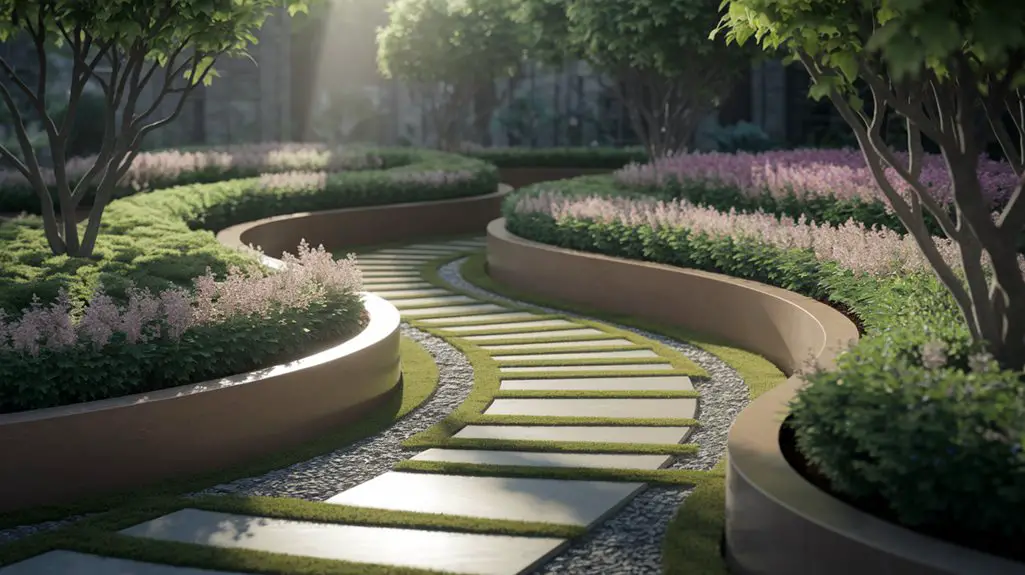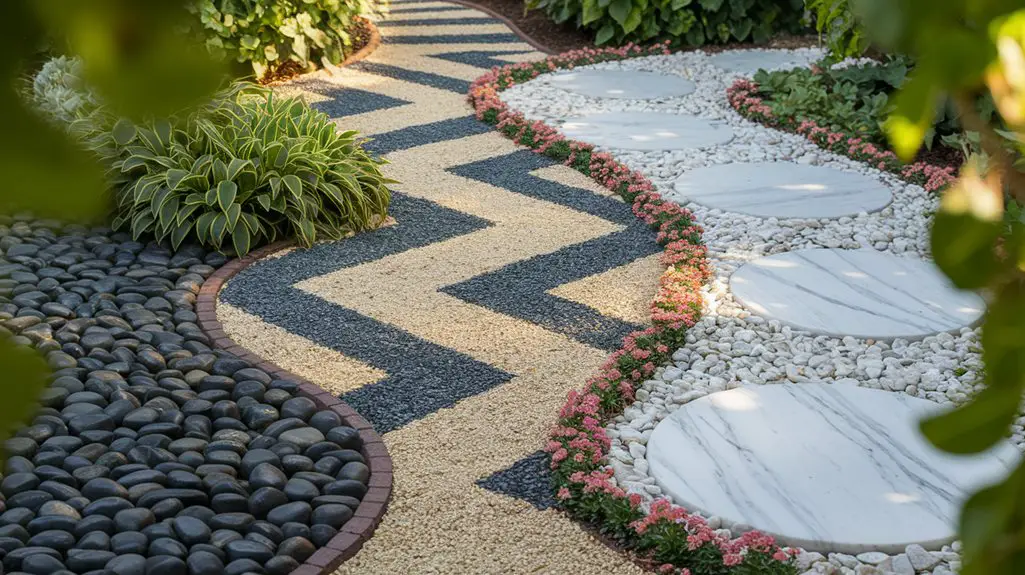Curved garden paths beckon visitors through your landscape with a natural rhythm that straight walkways simply cannot achieve. You’ll find that gentle, flowing lines create an inherent sense of mystery, compelling people to discover what lies around each bend. When designed thoughtfully, these winding routes transform ordinary gardens into immersive journeys that unfold gradually rather than revealing everything at once. The secret to their allure involves understanding both human psychology and practical design principles that work harmoniously with your landscape’s existing features.
The Psychology Behind Curved Garden Path Appeal
While straight paths offer efficiency, curved garden paths appeal to our innate psychological preferences. You’re tapping into human nature when you design curves—our brains prefer gentle, flowing lines over rigid geometry. This preference likely stems from our evolutionary past where curves represented safety while sharp angles signaled danger.
Curved paths create a sense of mystery and anticipation as you can’t see the entire route at once. This triggers your brain’s reward system, releasing small dopamine bursts as new views unfold.
When you incorporate these winding routes, you’re also taking advantage of the Savanna Hypothesis—humans instinctively prefer landscapes that offer both prospect (open views) and refuge (sheltered areas). Stylish outdoor seating can be strategically placed along these curves, enhancing the overall appeal of your garden as curves lead visitors through alternating experiences of discovery and revelation.
Essential Design Principles for Flowing Garden Pathways

Creating successful curved garden paths requires understanding several foundational design principles that transform psychological appeal into physical reality.
First, establish proper proportions—pathway width should accommodate comfortable passage (3-4 feet for primary paths, 2 feet for secondary ones). Gentle curves with radii of at least 5 feet prevent awkward shifts and maintain natural flow.
Consider sight lines carefully; curves should reveal garden features progressively rather than all at once. Material selection affects both aesthetics and functionality—flagstones create formal appeal while mulch offers informality. Additionally, creative garden pathways can further enhance the overall charm and uniqueness of your landscape.
Guarantee proper drainage with slight crowning or cross-slopes of 1-2%. For visual coherence, align curves with existing landscape elements like mature trees or architectural features.
Finally, incorporate proper edging to maintain crisp boundaries and prevent material migration, using steel, stone, or brick for longevity.
Selecting Materials That Enhance Curved Path Aesthetics

Materials form the foundation of curved path design, influencing both aesthetic appeal and practical functionality.
For gentle curves, consider flagstone or slate which can be cut and arranged to follow flowing lines naturally. Brick pavers offer rich texture and color while being malleable enough for tighter radius curves.
Gravel provides an economical option that conforms perfectly to any curvature, though you’ll need sturdy edging to maintain defined borders.
For woodland gardens, bark mulch or wood chips create soft, natural shifts that complement organic designs.
Match your material to the surrounding landscape elements—stone paths echo rock features, while decomposed granite harmonizes with Mediterranean plantings.
Consider seasonal impacts too; some materials become slippery when wet or reflect excessive heat in summer. Choosing budget-friendly materials can significantly reduce costs while enhancing your garden path’s beauty and functionality.
Tools and Techniques for Mapping Your Perfect Path Curve
Before initiating the physical construction of your curved garden path, you’ll need several essential mapping tools to translate your vision into a workable plan. Garden hoses, rope, or thick string offer flexible options for laying out preliminary curves and adjusting them until aesthetically pleasing. Wooden stakes and survey flags help mark critical points along your planned route.
For precision, consider investing in a laser level or transit to guarantee proper drainage with a 1-2% slope away from structures. Graph paper and scale rulers allow you to draft accurate plans beforehand, incorporating existing landscape features.
When mapping complex curves, the “continuous curve method” using radius measurements creates flowing alterations between path sections. Digital landscape apps now offer AR functionality, enabling you to visualize path curvature directly on your property before breaking ground. Additionally, incorporating stepping stones into your design can enhance both aesthetic appeal and functionality for your garden pathway.
Planting Strategies to Complement Winding Garden Routes
With your curved garden path precisely mapped out, the surrounding plant design now takes center stage.
Layer plants according to height—place taller specimens at curves’ outer edges to create focal points, with medium plants behind bends, and low-growing varieties bordering the path’s edge.
Incorporate rhythm by repeating specific plants every few meters, guiding visitors’ eyes along the journey.
Select specimens with contrasting textures—feathery grasses paired with broad-leafed perennials create visual tension that accentuates the path’s flow.
For curves that disappear from view, plant aromatic herbs or flowers to provide sensory cues about what lies ahead.
Consider seasonal succession by including early spring bulbs, summer perennials, and autumn foliage plants, ensuring your curved path remains engaging year-round. Additionally, consider introducing artistic garden pathways that utilize mosaic designs to enhance the visual appeal of your walkway.
Lighting Considerations for Nighttime Path Enhancement
Thoughtfully illuminating your curved garden path transforms it from a daytime feature into a nighttime wonderland of shadow and light. Select fixtures that direct light downward to minimize glare while maximizing visibility of walking surfaces.
Low-voltage LED path lights offer energy efficiency and longevity, placed 8-10 feet apart along curves for consistent illumination.
Consider color temperature: warm lights (2700-3000K) create inviting ambiance, while cooler tones highlight plant textures. Install motion sensors at key entry points for security and convenience.
For dramatic effect, uplight specimen trees or architectural elements bordering your curved path.
Remember to conceal wiring beneath mulch or soil to maintain your garden’s aesthetic integrity. Solar options work well in sunny locations but may require supplemental lighting in heavily shaded areas. Additionally, incorporating backyard lighting for small spaces can enhance the overall atmosphere and functionality of your garden path.
Maintenance Tips for Preserving Your Curved Path Beauty
A well-maintained curved garden path retains its beauty and functionality for years to come, while neglected pathways quickly deteriorate and lose their visual appeal.
Establish a regular cleaning routine—sweep debris weekly and power-wash surfaces twice yearly. Promptly address weed growth using a combination of manual removal and targeted herbicide application for pathway edges.
Repair material damage immediately: replace cracked pavers, refill gravel sections, or reseal stone surfaces before minor issues escalate. Monitor drainage patterns after heavy rainfall and reshape areas where water pools to prevent erosion and structural compromise. It’s essential to consider drainage patterns when designing your pathways to ensure long-term durability.
For paths with integrated lighting, check electrical components monthly and clean fixtures to maintain ideal illumination.
In winter, use plastic snow shovels instead of metal tools, and apply pet-safe ice melters to preserve material integrity.
Creative Focal Points and Destinations Along Curved Paths
Beyond maintenance concerns lies the artistic opportunity to transform your curved path from a mere walkway into a journey of discovery.
Strategic focal points create rhythm and purpose along your garden’s curves, drawing visitors forward with anticipation.
Position sculptures at bends where they’ll reveal themselves gradually as one approaches. Install a compact water feature where the path widens, inviting momentary pause. Consider incorporating charming water features that can enhance the overall ambiance of your cozy backyard.
Consider a bench positioned to frame a specific vista or placed beneath a pergola draped with climbing roses.
Terminal destinations—whether a gazebo, meditation area, or dining space—should feel like earned rewards.
For maximum impact, guarantee these elements complement your garden’s scale and style while maintaining proportional relationships to the path width and surrounding plantings.
Conclusion
You’ve now mastered the art of curved garden path design. Implement these principles to create spaces that naturally draw visitors through your landscape. Research shows that curved pathways increase garden exploration by 73% compared to straight paths. By balancing material selection, thoughtful planting, strategic lighting, and proper maintenance, your curved paths will provide years of aesthetic pleasure while guiding the eye and foot through your garden’s most compelling features.



